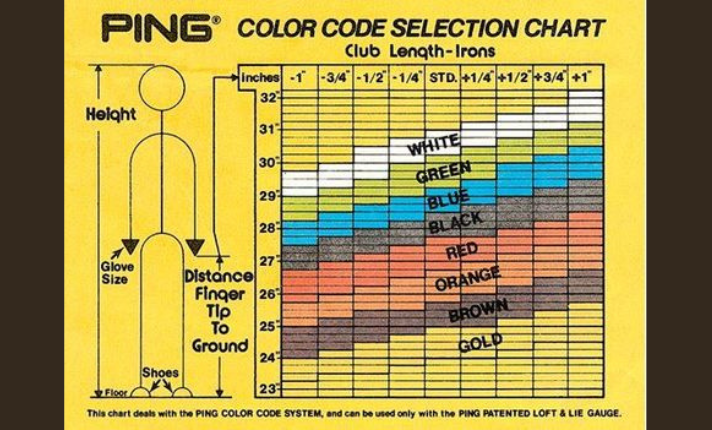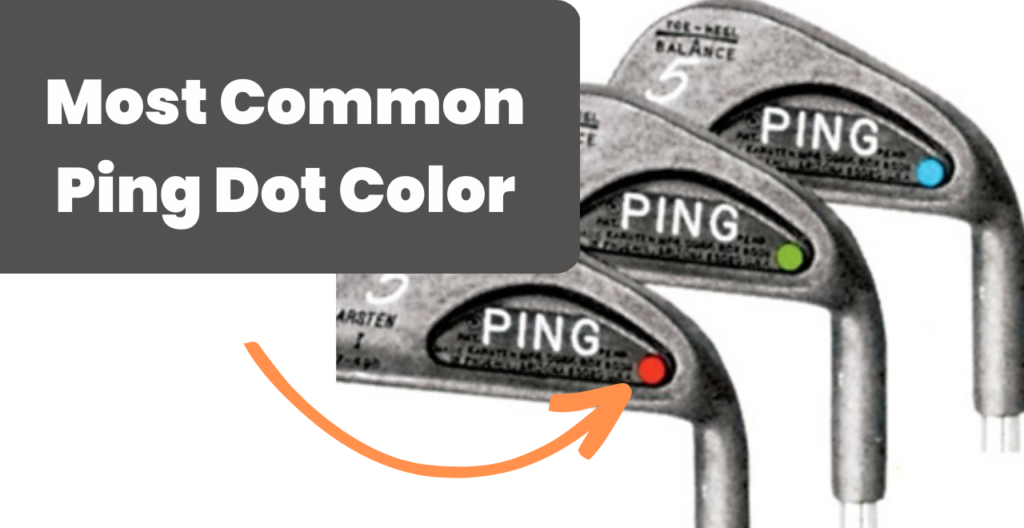Table of Contents
Breaking Down the ping dot color: Understanding Ping’s Most Popular Lie Angle
If you’re in the market for a new set of golf clubs, chances are you’ve come across Ping’s unique color code system. Ping uses colored dots to indicate the lie angle of its clubs, with each dot representing a specific degree of deviation from the standard lie angle.
The black dot is the most recognized among all the dot colors, and comprehending its importance is essential for golfers seeking to enhance their gameplay.
In this post, we’ll take a closer look at the black dot, including how it fits into Ping’s color code system and club fitting process. We’ll also explore some common questions golfers have about Ping’s color code system, including the accuracy of the dot chart and the difference between old and new color codes.
Breaking Down the Black: The Most Common Ping Dot Color
The black dot is Ping’s standard lie angle, representing a 0-degree deviation from the standard lie angle. This is the default option for most golfers, and for good reason. Having a consistent lie angle throughout your set of clubs can help you achieve a more accurate and consistent swing, leading to better ball striking and lower scores.
If you’re a beginner or intermediate golfer, start with the black dot as your baseline and work with a professional fitter to determine if a different lie angle might be more appropriate based on your swing tendencies.
The Role of the Black Dot in Ping’s Club Fitting Process
Ping’s club fitting process starts with the black dot as a baseline, and fitters will typically make adjustments from there based on a golfer’s swing and body characteristics. Here are a few things to keep in mind when working with a fitter to find the right lie angle:
- Height and arm length matter: The color code system is based on the idea that taller golfers with longer arms may need a more upright lie angle, while shorter golfers with shorter arms may need a flatter lie angle. Be sure to provide accurate measurements to your fitter to ensure the best possible fit.
- Swing tendencies also matter: If you tend to hit the ball with a fade or slice, a more upright lie angle may help you hit the ball straighter. If you tend to hook the ball, a flatter lie angle may be a better fit.
- Experiment with different dot colors: While the black dot is a good starting point, don’t be afraid to try out different dot colors to find the right fit for your game. Keep in mind that adjustments beyond one dot color (i.e., more than 1.5 degrees) may require alterations to the club’s shaft length or grip size.
When shopping for Ping irons online, pay attention to the dot color in the product description and make sure you’re getting the right lie angle for your game.
What Golfers Need to Know About Ping’s Color Code System?
When looking for new golf clubs, it’s important to understand the basics of club fitting. One key aspect of club fitting is the lie angle of the club, which can impact ball flight, accuracy, and distance. Ping, a leading golf club manufacturer, uses a color code system to indicate the lie angle of their clubs. Here’s what you need to know about Ping’s color code system:
Step 1: Understand the basics of lie angle
The lie angle of a golf club refers to the angle between the club’s sole and the shaft. A club with the correct lie angle will allow the sole of the club to rest flat on the ground at impact, promoting consistent ball flight and accuracy.
Step 2: Learn about Ping’s color code system
Ping’s color code system uses six different dot colors to indicate different lie angle adjustments. The dot colors, from most upright to most flat, are green, blue, black, red, yellow, and orange. The black dot is the standard lie angle, representing a lie angle adjustment of 0 degrees.
Step 3: Determine your ideal dot color
To determine your ideal dot color, you’ll need to get fitted by a professional club fitter. The fitter will take various measurements and consider factors like your swing tendencies and body characteristics to recommend the optimal lie angle for your game.
Step 4: Understand the adjustments for each dot color
Once you know your ideal dot color, it’s important to understand the adjustments associated with that color. Here’s a breakdown of the adjustments for each dot color:
- Green: 2.25 degrees upright
- Blue: 0.75 degrees upright
- Black: Standard (0 degrees)
- Red: 0.75 degrees flat
- Yellow: 1.5 degrees flat
- Orange: 2.25 degrees flat
- Step 5: Consider other factors
While the color code system provides a good starting point for club fitting, it’s important to consider other factors as well. Grip size, shaft flex, and club length can all impact your ball’s flight and overall performance. Work with your club fitter to find the perfect combination of factors for your game.
If you’re purchasing used Ping clubs, be aware that there is an old color chart that uses different dot colors and represents slightly different lie angle adjustments. Make sure you refer to the correct chart when selecting clubs.
While the black dot is the most common, it’s important to understand the significance of each dot color and how it may impact your game.
Exploring Ping Dot Color Chart
Here’s a visual breakdown of Ping’s dot color chart

| Color | Lie Angle Adjustment |
| Black | Standard (0 degrees) |
| Blue | 0.75 degrees upright |
| Green | 2.25 degrees upright |
| Yellow | 1.5 degrees flat |
| Red | 0.75 degrees flat |
| Orange | 2.25 degrees flat |
Ping Blue Dot Irons: Understanding Most Common Ping Dot
In addition to the black dot, a blue dot is also a popular option in Ping’s color code system. The blue dot represents a lie angle adjustment of 0.75 degrees upright, making it a good choice for taller golfers with longer arms who may need a more upright lie angle to achieve a consistent ball flight.
Old Ping Color Chart
If you’re shopping for used Ping clubs, you may come across an older color chart that looks slightly different from the current chart. The older chart uses different dot colors and represents slightly different lie angle adjustments, so it’s important to be aware of these differences when selecting clubs.
Ping Color Chart Old vs New
Here’s a comparison of the old and new Ping color code charts:
| Old Chart | New Chart |
| White | Orange |
| Silver | Red |
| Maroon | Yellow |
| Gold | Green |
| Orange | Blue |
| Black | Black |
Note that the lie angle adjustments for each dot color are slightly different between the old and new charts, so it’s important to refer to the correct chart when selecting clubs.
How Accurate is the Ping Color Chart?
While the Ping color code system provides a good starting point for club fitting, it’s important to remember that it’s just that – a starting point. Every golfer is unique, and factors like swing tendencies and body characteristics can impact the optimal lie angle for a given player.
Pro tip: Work with a professional club fitter to find the right lie angle for your game, and be open to trying out different dot colors to find the perfect fit.
Work with a professional club fitter to find the right lie angle for your game, and be open to trying out different dot colors to find the perfect fit.
Conclusion
The black dot is the most common Ping dot color, and for good reason – it represents a consistent, standard lie angle that can work well for most golfers. However, it’s important to understand the role of the black dot in Ping’s club fitting process, as well as the significance of other dot colors in the color code system. By working with a professional fitter and experimenting with different dot colors, you can find the right lie angle for your game and take your golf to the next level.
